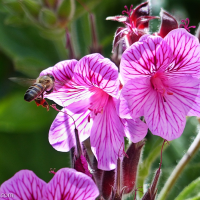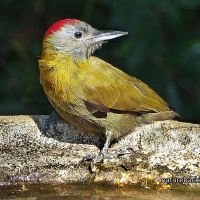Mountains, cliffs, forests, grasslands, flowers, clear streams and waterfalls, the Drakensberg has all that and more to delight and sometimes challenge a hiker.

On our first day hike we had this view of the massive face of Cathkin Peak with Sterkhorn to the right, both capped in cloud. The smaller peaks of the Tower (or Turret) and the Amphlett are clearly visible further to the right against the skyline
In early May we stayed for a few days in the area known as Cathkin Park or Champagne Valley – both names referencing two of the tallest mountains in the region: Cathkin Peak (3148 m) and Champagne Castle (3377 m). During our stay we did two short day hikes of a few kilometres each, with both involving a bit of climbing up and down steps cut in the steep sections of the mostly well-maintained footpaths. Both hikes involved walking through forest patches along streams gushing at full strength after heavy rains and through grasslands with views up to the sandstone cliffs of the Little Berg and up to the main Drakensberg Mountains.

In deep shade, only two flowers of this everlasting (Helichrysum sp.) caught the morning sunshine

Our destination was Nandi Falls, cascading over a lip of rock in a forested kloof (steep-sided ravine) in the Little Berg. ‘Nandi’ is Zulu for ‘beautiful’ – the forest is beautiful too

The falls were unusually full after the prolific rain in recent weeks

Falling water to the left of the photo merges with fronds of grass seemingly mimicking water as they hang down on the damp cliff face next to the falls

A rainbow at the bottom of the falls (photo by my spouse)

On our return from the falls we stopped and perched on a large boulder next to the footpath to eat our sandwiches. This was our view. The orange flowers, familiar from our garden, are Wild Dagga (Leonotis leonurus)

Looking up at the sandstone cliffs of the Little Berg

Recent cold weather had dried off the grasses even though the ground is very wet and in many places muddy. The grasses are brightened by wild flowers including these yellow Helichrysums

A resplendent yellow flowers visited by a species of tiny beetles (photo by my spouse)

We returned the way we had come to our accommodation (in one of two cabins for couples), which are concealed in a patch of forest. Above the forest the ground rises steeply to a band of sandstone cliffs. The prominent rock named the Sphinx can be seen in approximately the middle of the horizon. The high koppie on the right is named Verkykerskop

This is a section of Breakfast Stream that flows through the forest patch not far from the cabins

The next morning, our walk would take us up to the Sphinx, but on a roundabout route via Crystal Falls. Much of the footpath consists of steps secured with logs fixed to the ground with metal bars to prevent erosion

Further up, Breakfast Stream, surrounded by lush vegetation, was flowing fast. The water is perfectly clear and what a pleasure to be able to drink mountain water straight from the stream

Tiny flowers of Lobelia vanreenensis show up bright white amongst a jumble of foliage on a damp and shady bank near the stream. The plant is named for Van Reenen’s Pass

Another view of the stream rushing and gurgling to the edge of a slab of rock to cascade down a few metres before continuing on its way

By now we have climbed a little higher and we look back at the forest on either side of the two streams that fall over the sandstone cliffs to combine together into the continuation of Breakfast Stream

And as our path takes us higher still, we look back to see the mountains coming into sight above the nearby promontory. Part of Cathkin Peak is only just visible, next is Sterkhorn, and to the right the Tower (or Turret) and the Amphlett. The trees in the foreground are a species of Protea

Just before the path curves around a hillside where we lose sight of the mountains, we look back to see Cathkin Peak more clearly. Cathkin Peak rises to a height of 3,148 m (about 10,330 feet). Its name comes from Scottish settlers who arrived in the region in the mid 1800s

On an easier and more level part of the hike I took more notice of the flowers including yet another unidentified species of Helichrysum, this one hosting an assassin bug
There are 244 species of Helichrysum in South Africa, and I have not observed carefully enough the characteristics of the flowers as well as the leaves to be able to distinguish them with any degree of accuracy. The genus name Helichrysum, derives from the Greek helios meaning sun and chrysos meaning gold. Most Helichrysum flowers are golden yellow in colour.

Another yellow flower that peeks out from amongst the grasses is this species of Sebaea

A fresh flush of leaves on this shrubby Protea glow red in the sunlight

Yet another species of everlasting Helichrysum, this one with a golden centre to the flower that is visited by a rather decorative fly

These Helichrysums grow in small clumps on silver rather hairy stems. The back of the petals are edged in delicate pink

These Helichrysums are a much richer and rosier pink, especially on the backs of the petals

Very tiny Oxalis flowers growing on the path, and somehow not stepped on as yet

A bit overwhelmed by the sunlight is this long-stalked Nerine. I forgot to note any leaves (it was protruding through dense grasses and bracken not far from a stream) but it is possibly Nerine bowdenii, known as the Large Pink Nerine

Me, negotiating a slippery section on the path through a forest patch near a stream

The stream well below Crystal Falls – a small torrent disappearing over the edge of a layer of rock, with forest on the one side and a grassy slope on the other

And then it was a long and strenuous climb up to the sandstone cliffs. Parts of the path were a bit crumbled and some of the wooden steps had been partially burnt away in a fire. Some sections had steep drop-aways close to the path to the right, which not having a head for heights I tried to ignore

Finally up near the cliffs and a short section of level pathway

The long narrow ribbon of water forming Crystal Falls. We took a break in the cool damp of the forest watching the water and listening to its small roar

After leaving the falls we followed the Bridle Path and doubled-back towards the Sphinx. And here we are at the Sphinx with a different view of Cathkin Peak. From this higher vantage point we catch a glimpse of Champagne Castle peeping up over the shoulder of ridge to the left of Cathkin Peak. To the right is Sterkhorn
From this angle Cathkin Peak massively dominates the skyline. The Zulu name for the peak is ‘Mdedelelo’, which means ‘make room for him’ or ‘the bully’ because, detached from the main wall of the Drakensberg escarpment, it looms so large and dominates the range. In fact Champagne Castle is higher, and is the second highest peak in South Africa (there are higher peaks in Lesotho), but from this angle its size and height cannot be appreciated.
With its massive basalt cliffs, Cathkin Peak is difficult to climb. An attempt to climb it in 1888 was defeated by the last precipitous 150 metres. It was successfully climbed only in 1912. Subsequent climbs, some up different routes, have resulted in summiting the peak, although several climbers lost their lives in the process.
The smaller Sterkhorn at 2973 m (9754 ft) is much easier – especially ascending the slightly lower peak. Summiting that peak does not involve any real climbing and it is really more of a challenging hike, but the last section is very steep. In fact about 20 years ago my spouse and I joined a group that did climb it, although I did not do the last rocky section, not having a head for heights, but perhaps that hike is a story for another day.

Near the Sphinx delicate-blue Wahlenbergia flowers with surprising blue stamens were nodding in the breeze

And then it was down again – mercifully some sections of the path zigzagged to spare the old knees, but other sections were quite steep. This is a view away from the mountains down towards the Midlands of KwaZulu-Natal

Back down at the stream we admired this fern the fronds of which forked into two as it grew. Perhaps this is Gleichenia umbraculifera (possibly renamed Sticherus umbraculiferus). It is a most striking plant whatever the name

Back into the forest to enjoy the streams, and then back to the cabin before the temperature dropped as the sun dipped behind the mountains
Sources:
Bristow, David. 1988. Drakensberg Walks: 120 Graded Hikes and Trails in the ‘Berg. Cape Town: Struik.
Pooley, Elsa. 2003 (2013). Mountain Flowers: A Field Guide to the Flora of the Drakensberg and Lesotho. Durban: The Flora Publications Trust.
Posted by Carol









June 21, 2022 at 3:03 am
Trying valiantly to get caught up… of course your post was one of the not-to-miss variety! And I’m so happy I got to see this incredible hike and the accompanying photographs. Of course those waterfalls and flowers and amazing scenes were wonderful. I marvel at your intrepid hiking… well worth the effort it seems!
LikeLiked by 1 person
June 23, 2022 at 9:06 pm
It was worth the climbing up and down. It was not far, but it was steep! We took plenty of time to smell, or rather photograph the flowers 🙂
LikeLike
June 8, 2022 at 11:26 am
The ‘Berg is the most amazing place to visit, and I enjoyed travelling with you both on your hike in the Berg. Sadly it is one of those places I did not visit as often as I would have liked to. I still have my ‘A Field Guide to the Natal Drakensberg’ published in 1980 with me, although I am now living too far away to make use of it! I think I need to visit it again!
LikeLiked by 1 person
June 10, 2022 at 8:31 pm
We also should try to visit there more often while we can. Nice to know that you have taken your SA books with you!
LikeLiked by 1 person
June 6, 2022 at 8:28 pm
I enjoy these kinds of hikes that provide moderate exercise, wonderful distant views, but also plenty to look at right underfoot. Thanks for taking us along into your gorgeous setting.
LikeLiked by 1 person
June 7, 2022 at 7:12 pm
Yes it makes for very engrossing walking! The variation of forest and grassland, and focusing on near or far means never a dull moment 🙂
LikeLiked by 1 person
June 6, 2022 at 3:48 am
I love this area of the Drakensberg Carol, your post evokes so many beautiful memories, thank you! xxxx
LikeLiked by 1 person
June 6, 2022 at 6:47 pm
The views of Cathkin Peak are so impressive and one immediately feels that one is really in the mountains.
xxx
LikeLiked by 1 person
June 5, 2022 at 2:18 pm
This was an awesome hike, Carol. I was simultaneously stunned by the vast vistas and anxious from the arduous hike. The heights and steepness and the narrow trails were just the kind that I appreciate with awe from my keyboard. I really enjoyed your narrative and descriptions, and the photos were fantastic. Wonderful to see close-ups of the flora too. That hairy stemmed flower is unique. Also really enjoyed the insects, especially the “decorative” fly and assassin bug. Fantastic post, Carol.
LikeLiked by 1 person
June 5, 2022 at 8:05 pm
Thanks Jet and glad you enjoyed the hike from your keyboard! The camera provides perfect reasons for taking little breaks along the trail 🙂 I was happy to include some insect pics but the birds were too flitty to get any usable pics. The vast vistas are wonderful and it is possible to gaze for ages watching the clouds change, or to sit in the dynamic presence of streams or waterfalls.
LikeLiked by 2 people
June 5, 2022 at 12:19 pm
I loved following your explorations of this section of the Berg. The flowers were especially beautiful. I do miss it!
LikeLiked by 1 person
June 5, 2022 at 7:56 pm
Thanks Christine. It always surprises me how many flowers can be found in the grasslands even in early winter.
LikeLike
June 4, 2022 at 11:56 am
Ah, the majestic Drakensburg. Thank you for this vicarious visit through your outstanding photographs of things both huge and tiny.
LikeLiked by 1 person
June 4, 2022 at 8:22 pm
Thank you Mariss. It is hard to do any kind of justice to both the huge and the tiny, but it was nice to share some of what we saw.
LikeLiked by 1 person
June 4, 2022 at 8:10 am
That’s a great park with so many beautiful views and lovely plants. Thanks for taking us along, Carol.
LikeLiked by 1 person
June 4, 2022 at 8:20 pm
It is a fantastic space – I enjoyed sharing some of what we saw on our walks.
LikeLiked by 1 person
June 4, 2022 at 4:09 am
Wonderful hikes and wonderful photos. I particularly love the everlasting plant photo and the waterfall photos below that.Looks like a good deal of effort was required but the rewards are obvious.
LikeLiked by 1 person
June 6, 2022 at 6:34 pm
Thanks Graham. I was quite surprised at the way the everlasting flowers showed up out of the shadow in that way. We were lucky to see the waterfall so exceptionally full. The walks were not long but some sections seemed endlessly steep! Worth it though 🙂
LikeLiked by 1 person
June 3, 2022 at 8:18 am
Brings back good memories from a long time back.
LikeLiked by 1 person
June 4, 2022 at 8:17 pm
Glad to bring back good memories of the mountains. It is an especially beautiful place.
LikeLike
June 3, 2022 at 7:45 am
Now there’s a challenging hike I’d love to take: with you as my guide. It does look a toughie – you’d merit the rewards of the views and natural life you see.
LikeLiked by 1 person
June 4, 2022 at 8:16 pm
Would be lovely if you could join us! In exchange you could take us yomping in Yorkshire!
LikeLike
June 4, 2022 at 8:22 pm
It’s a deal!
LikeLiked by 1 person
June 4, 2022 at 8:45 pm
👍 🙂
LikeLike
June 3, 2022 at 4:35 am
I have loved every picture as I scrolled down! It was during my years in Pietermaritzburg – both as a student and later – that I got to know the ‘Berg intimately. We hiked there almost every weekend for years, and especially when my husband was finalising his guide to the Drakensberg. Your description had me following the path with you: I could smell the scents, was puffing out of breath at times, and could taste that water … a wonderful experience which you have documented beautifully.
LikeLiked by 3 people
June 4, 2022 at 8:15 pm
I am happy this piece helped rekindle your memories of your hikes in the Drakensberg. Years back we lived in Ladysmith for a few months and got to know the Royal Natal National Park quite well, hiking there most weekends. Drinking that mountain water is so special! And the scents and sounds are an intense part of the whole experience of walking there.
LikeLiked by 2 people
June 3, 2022 at 2:39 am
Oh wow, Carol! What a beautiful part of “The ‘Berg” this is! Thank you for every last photo you shared here, it felt as if I could feel the sun on my face, smell the scent of the grass and hear the gurgling of the streams.
We have never visited the Cathkin Peak area before – we really should remedy that, even more so considering that we haven’t been back to the Drakensberg since we had to cut short our visit in March 2020 when the first hard lockdown was announced.
LikeLiked by 1 person
June 4, 2022 at 8:09 pm
It seems that you owe yourselves another trip to the lovely Drakensberg. We are a bit spoilt for choice as to where to go to though! The Cathkin area is very lovely.
I am glad we were there ahead of the change in the weather and the snow on the high mountains.
LikeLiked by 1 person
June 2, 2022 at 10:20 pm
Looks like a vigorous hike, Carol. But the lofty views were well worth the climb, I expect. Gorgeous country! Was it very hot during the day?
LikeLiked by 1 person
June 4, 2022 at 8:05 pm
Thanks Eliza- yes it is gorgeous. It got quite hot in the middle of the day, but still a slight nip in the breeze – but hot by your standards! As the sun drops the temps drop with it.
LikeLike